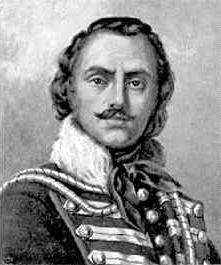
Posted on 06/21/2005 8:05:51 PM PDT by Pharmboy
SAVANNAH, Ga. (AP) - DNA tests on bones exhumed from a monument to Brig. Gen. Casimir Pulaski failed to prove the remains are those of the Revolutionary War hero killed in a 1779 battle to retake Savannah from the British. But a draft report on the investigation into Pulaski's disputed burial says historical records and skeletal injuries make a case that the remains are those of the Polish nobleman.
"While the strong circumstantial evidence does suggest that the remains are Casimir Pulaski, the inability to obtain a DNA match leads to no viable conclusion," says the report obtained by The Associated Press.
Dr. James C. Metts Jr., the Chatham County coroner, hoped DNA testing of the remains exhumed in 1996 would settle the question of whether Pulaski was buried at sea or placed in an unmarked grave.
The debate has divided historians since the bones were removed from the grave at a ruined plantation and moved in 1854 to Savannah's Monterey Square, where the 54-foot Pulaski monument was erected a year later.
"To our great frustration, we were unable to solve the mystery," said Chuck Powell, administrator of the investigative committee led by Metts. "The final report, other than giving more complete information, will probably not change in its conclusions."
Metts submitted the draft to Savannah officials in November. The city released the findings after the AP requested a copy last week.
Known as the father of the American cavalry, Pulaski came to America in 1777. He was mortally wounded during the October 1779 siege of Savannah.
Examinations of the skull and bones seemed to match what's known of Pulaski's age, height and facial features. A healed fracture to the right hand fits an injury Pulaski once described in a letter. A bone tumor on the forehead fits a wound he suffered fighting the Russians in Poland.
But without more solid proof, it's difficult to debunk Pulaski's burial at sea. Two officers who served under Pulaski wrote accounts of his watery grave. One of them, his aide-de-camp, said he witnessed the burial.
Investigators had hoped to match DNA from the bones to two of Pulaski's deceased relatives in Poland. In one case, the test was inconclusive. In the other, the woman's remains failed to yield enough DNA to examine.

A hero proved in liberating strife.
Cheers to the memory of this friend of the American Revolution.
Pinging the majordomos of the Gods, Graves and Glyphs list.
There were SEVERAL far better cavalry officers than Pulaski.
There was: Col. Harry Lee of 1st Dragoons.
There was Col.Sheldon of the 3rd Dragoons
There was: Col. William Washington of the 3rd Dragoons.
There was Col. Stephen Moylan of the 4th Dragoons.
Pulaski was a late comer to the American cavalry scene and drew MOST his troopers from the other regiments of Contential Dragoons. While very nice that he came over to volunteer his services, ALL the other AMERICAN Dragoon leaders were far superior to him in skills and ALL of them survived the war and were not known to be foolhardy or brash in battle.
May I suggest any person who wants to know more about American Dragoons, google the subject.
Sorry, it is Col. Sheldon of the 2nd Dragoons( not 3rd).
Casimir Pulaski (1747-1779)
Pulaski Image
After surviving numerous bloody campaigns against Russia, Count Casimir Pulaski retired to France in 1777, bitterly disappointed and deeply depressed at Poland's failure to defeat her foes.
In Paris Pulaski met Benjamin Franklin, who was recruiting volunteers to fight in America's War of Independence. Mindful that England had recommended that Poland be partitioned by her hostile neighbors in 1772, Pulaski enthusiastically responded to Franklin's plea for assistance. In his letter of introduction to Washington, Franklin wrote of Pulaski as "an officer famous throughout Europe for his bravery and conduct in defense of the liberties of his country against ... great invading powers".
While awaiting his formal appointment by Congress, Pulaski was invited by Washington to serve on his staff during the Battle of Brandywine in September, 1777. Pulaski's performance during this baptism of blood in America earned him a commission as Brigadier General of the entire American cavalry.
Pulaski on Battlefield
In 1779, Pulaski was ordered to join General Lincoln in the South to help recapture Savannah. After French General D'Estaing, leader in the attack on the southern capital, fell wounded, Pulaski is reported to have rushed forward to assume command and raise the soldiers' spirits by his example and courage, only to be mortally wounded himself. Pulaski was named the "Father of American Cavalry", and remains one of the well known figures of the American Revolutionary War. There is hardly a state in America without a county or town, street or square, monument or tablet, school or highway named in grateful memory of General Casimir Pulaski.

military history ping
A Forgotten Hero of the American War for Independence: Marquis de la Rouerie
Reminds me of the Chinese cultural revolution.
Please FREEPMAIL me if you want on, off, or alter the "Gods, Graves, Glyphs" PING list --
Archaeology/Anthropology/Ancient Cultures/Artifacts/Antiquities, etc.
The GGG Digest -- Gods, Graves, Glyphs (alpha order)
When I get an application from a kid and the resume says "Brown University" they need to be super-terrific to overcome that obstacle in my mind.
Going to check out that link to "The Marquis de la Rouerie".
Thanks for the post...............Polish Heritage (4th generation removed) Bump!
Military history bump.
Disclaimer: Opinions posted on Free Republic are those of the individual posters and do not necessarily represent the opinion of Free Republic or its management. All materials posted herein are protected by copyright law and the exemption for fair use of copyrighted works.